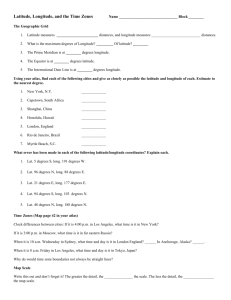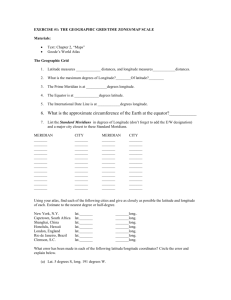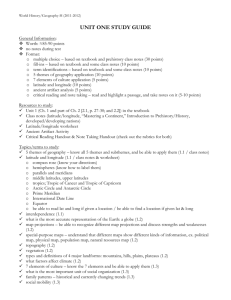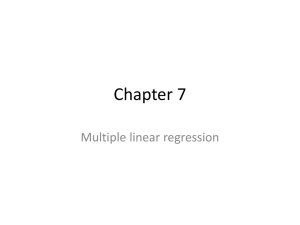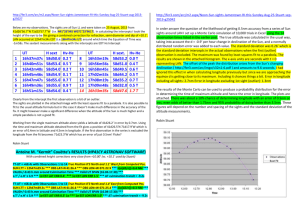Maximum January Temperature
advertisement
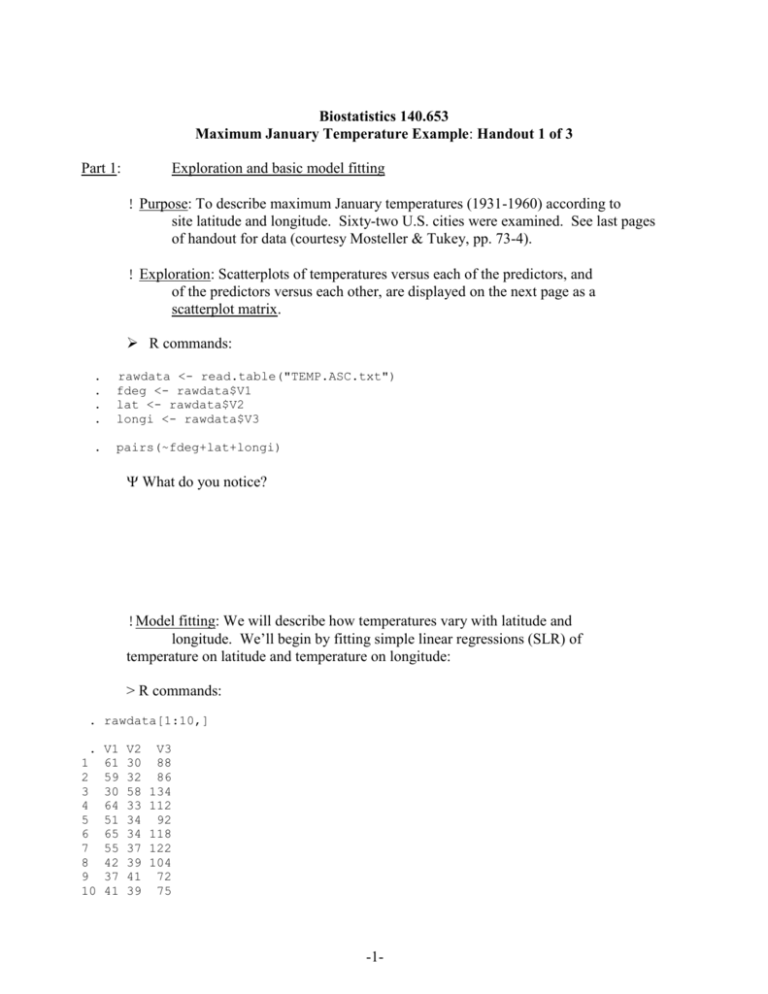
Biostatistics 140.653 Maximum January Temperature Example: Handout 1 of 3 Part 1: Exploration and basic model fitting ! Purpose: To describe maximum January temperatures (1931-1960) according to site latitude and longitude. Sixty-two U.S. cities were examined. See last pages of handout for data (courtesy Mosteller & Tukey, pp. 73-4). ! Exploration: Scatterplots of temperatures versus each of the predictors, and of the predictors versus each other, are displayed on the next page as a scatterplot matrix. R commands: . . . . rawdata <- read.table("TEMP.ASC.txt") fdeg <- rawdata$V1 lat <- rawdata$V2 longi <- rawdata$V3 . pairs(~fdeg+lat+longi) What do you notice? !Model fitting: We will describe how temperatures vary with latitude and longitude. We’ll begin by fitting simple linear regressions (SLR) of temperature on latitude and temperature on longitude: > R commands: . rawdata[1:10,] . 1 2 3 4 5 6 7 8 9 10 V1 61 59 30 64 51 65 55 42 37 41 V2 30 32 58 33 34 34 37 39 41 39 V3 88 86 134 112 92 118 122 104 72 75 -1- -2- . tempdata <- subset(rawdata, (rawdata$V3<130 & rawdata$V2<=50 & rawdata$V2>20)) . fdeg <- tempdata$V1 . lat <- tempdata$V2 . longi <- tempdata$V3 . latc <- lat-39 . longc <- longi-76 . cbind(fdeg, lat, longi, latc, longc)[1:10,] [1,] [2,] [3,] [4,] [5,] [6,] [7,] [8,] [9,] [10,] fdeg lat longi latc longc 61 30 88 -8.440678 -2.101695 59 32 86 -6.440678 -4.101695 64 33 112 -5.440678 21.898305 51 34 92 -4.440678 1.898305 65 34 118 -4.440678 27.898305 55 37 122 -1.440678 31.898305 42 39 104 0.559322 13.898305 37 41 72 2.559322 -18.101695 41 39 75 0.559322 -15.101695 44 38 77 -0.440678 -13.101695 ! First, the simple linear regression (SLR) of temperature on latitude. This gives us the so-called “total” effect of latitude on temperature: . summary(lm(fdeg~latc)) lm(formula = fdeg ~ latc) Residuals: Min 1Q Median -8.767 -3.782 -0.900 3Q Max 1.363 22.811 Coefficients: Estimate Std. Error t value Pr(>|t|) (Intercept) 43.2034 0.8022 53.85 <2e-16 *** latc -2.2370 0.1520 -14.71 <2e-16 *** --Signif. codes: 0 `***' 0.001 `**' 0.01 `*' 0.05 `.' 0.1 ` ' 1 Residual standard error: 6.162 on 57 degrees of freedom Multiple R-Squared: 0.7916, Adjusted R-squared: 0.7879 F-statistic: 216.5 on 1 and 57 DF, p-value: < 2.2e-16 ! And, the total effect of longitude on temperature: . summary(lm(fdeg~longc)) lm(formula = fdeg ~ longc) Residuals: Min 1Q -23.599 -9.999 Median -1.759 3Q 7.961 Max 33.201 -3- Coefficients: Estimate Std. Error t value Pr(>|t|) (Intercept) 43.20339 1.75544 24.611 <2e-16 *** longc 0.03999 0.12002 0.333 0.74 --Signif. codes: 0 `***' 0.001 `**' 0.01 `*' 0.05 `.' 0.1 ` ' 1 Residual standard error: 13.48 on 57 degrees of freedom Multiple R-Squared: 0.001944, Adjusted R-squared: -0.01557 F-statistic: 0.111 on 1 and 57 DF, p-value: 0.7402 ! Do the two SLR’s describe the combined effect of latitude and longitude on temperature? ! Let’s fit a multiple linear regression (MLR) of temperature on latitude and longitude– e.g., estimate the ’s in: temp = 0 + 1LAT + 2LONG These are the so-called DIRECT effects of latitude and longitude on temperature. . fullmod.fit <- lm(fdeg~lat+longi) . summary(fullmod.fit) lm(formula = fdeg ~ lat + longi) Residuals: Min 1Q Median -8.8787 -3.3330 -0.8147 3Q Max 2.6711 24.2224 Coefficients: Estimate Std. Error t value Pr(>|t|) (Intercept) 117.34635 6.73846 17.414 < 2e-16 *** lat -2.29936 0.14348 -16.026 < 2e-16 *** longi 0.15811 0.05176 3.055 0.00345 ** --Signif. codes: 0 `***' 0.001 `**' 0.01 `*' 0.05 `.' 0.1 ` ' 1 Residual standard error: 5.756 on 56 degrees of freedom Multiple R-Squared: 0.8213, Adjusted R-squared: 0.8149 F-statistic: 128.7 on 2 and 56 DF, p-value: < 2.2e-16 ! Compare ! Do the Y vs. X scatterplots describe the SLR’s or the MLR? Summarize the total, direct, and indirect effects of latitude and longitude Total Direct Indirect (= Tot -Dir) LAT LONG -4- Part 2: Curve and discretized (ANOVA) fitting ! Preliminary: Delete three extremely outlying cities: Honolulu, Hawaii; Juneau, Alaska; San Juan, Puerto Rico. ! Now, refit multiple linear regression model . summary(lm(fdeg~lat+longi)) lm(formula = fdeg ~ lat + longi) Residuals: Min 1Q Median -8.8787 -3.3330 -0.8147 3Q Max 2.6711 24.2224 Coefficients: Estimate Std. Error t value Pr(>|t|) (Intercept) 117.34635 6.73846 17.414 < 2e-16 *** lat -2.29936 0.14348 -16.026 < 2e-16 *** longi 0.15811 0.05176 3.055 0.00345 ** --Signif. codes: 0 `***' 0.001 `**' 0.01 `*' 0.05 `.' 0.1 ` ' 1 Residual standard error: 5.756 on 56 degrees of freedom Multiple R-Squared: 0.8213, Adjusted R-squared: 0.8149 F-statistic: 128.7 on 2 and 56 DF, p-value: < 2.2e-16 ! . . . . Plot residuals versus each predictor fit.full <- lm(fdeg~lat+longc)$fit resid.full <- lm(fdeg~lat+longc)$resid plot(resid.full~fit.full,xlab="Fitted values", ylab="Residuals") abline(h=0) -5- 24.8194 ! Plot of residuals versus latitude shows no “pattern”. Check out plot versus longitude: e( temp | X,longtude ) . plot(resid.full~longi, xlab="longitude", ylab="e(temp|X, longitude)") . abline(h=0) -17.1815 70 -6- ! Based on the clearly nonlinear shape, we will fit curves to the longitude data # First, center the covariates . . . . k <- mean(lat) l <- mean(longi) latc <- lat-k longc <- longi-l # Generate quadratic longitude terms . lon2 <- longi^2 . lonc2 <- longc^2 -7- # Uncentered model . summary(lm(fdeg~lat+longi+lon2)) lm(formula = fdeg ~ lat + longi + lon2) Residuals: Min 1Q -6.46172 -2.08898 Median 0.01928 3Q Max 0.95892 24.91632 Coefficients: Estimate Std. Error t value Pr(>|t|) (Intercept) 278.815077 26.705618 10.440 1.17e-14 *** lat -2.523056 0.117093 -21.547 < 2e-16 *** longi -3.153633 0.538635 -5.855 2.76e-07 *** lon2 0.017465 0.002833 6.166 8.68e-08 *** --Signif. codes: 0 `***' 0.001 `**' 0.01 `*' 0.05 `.' 0.1 ` ' 1 Residual standard error: 4.466 on 55 degrees of freedom Multiple R-Squared: 0.8944, Adjusted R-squared: 0.8886 F-statistic: 155.2 on 3 and 55 DF, p-value: < 2.2e-16 # Centered model: notice the difference re longitude coeff, standard error . summary(lm(fdeg~latc+longc+lonc2)) lm(formula = fdeg ~ latc + longc + lonc2) Residuals: Min 1Q -6.46172 -2.08898 Median 0.01928 3Q Max 0.95892 24.91632 Coefficients: Estimate Std. Error t value Pr(>|t|) (Intercept) 39.467207 0.839802 46.996 < 2e-16 *** latc -2.523056 0.117093 -21.547 < 2e-16 *** longc -0.006349 0.048213 -0.132 0.896 lonc2 0.017465 0.002833 6.166 8.68e-08 *** --Signif. codes: 0 `***' 0.001 `**' 0.01 `*' 0.05 `.' 0.1 ` ' 1 Residual standard error: 4.466 on 55 degrees of freedom Multiple R-Squared: 0.8944, Adjusted R-squared: 0.8886 F-statistic: 155.2 on 3 and 55 DF, p-value: < 2.2e-16 # A technique to be learned in Class 7: The partial residual plot (good for curve fit check) # First, generate the partial residuals . coeff <- lm(fdeg~latc+longc+lonc2)$coeff . qadjy <- fdeg-(coeff[1]+coeff[2]*latc) -8- # Now, generate the fit . qfit <- coeff[3]*longc+coeff[4]*lonc2 # Graph the two versus one another . plot(qadjy~longc, xlab="longc") . points(qfit~longc, pch=22) ! Now, fit a linear spline model # First, generate spline terms. We’ll put knots at Louisville, KY and Albuquerque, NM . . lonspl1 <- (longi-85)*(longi>84) lonspl2 <- (longi-105)*(longi>104) # Now, fit the model . summary(lm(fdeg~latc+longi+lonspl1+lonspl2)) lm(formula = fdeg ~ latc + longi + lonspl1 + lonspl2) Residuals: Min 1Q Median -6.5511 -2.1684 -0.3600 3Q Max 1.0492 24.0080 -9- Coefficients: Estimate Std. Error t value (Intercept) 60.0792 12.1702 4.937 latc -2.4688 0.1165 -21.198 longi -0.2244 0.1536 -1.461 lonspl1 0.1383 0.2403 0.575 lonspl2 1.1868 0.2619 4.532 --Signif. codes: 0 `***' 0.001 `**' 0.01 Pr(>|t|) 8.02e-06 *** < 2e-16 *** 0.150 0.567 3.28e-05 *** `*' 0.05 `.' 0.1 ` ' 1 Residual standard error: 4.426 on 54 degrees of freedom Multiple R-Squared: 0.8981, Adjusted R-squared: 0.8906 F-statistic: 119 on 4 and 54 DF, p-value: < 2.2e-16 # Partial residual plot: . coeff2 <- lm(fdeg~latc+longi+lonspl1+lonspl2)$coeff . . . . sadjy <- fdeg-(coeff2[1]+coeff2[1]*latc) sfit <- coeff2[3]*longi+coeff2[4]*lonspl1+coeff2[5]*lonspl2 plot(qadjy~longi, xlab="longitude", ylab=””) points(sfit~longi, pch=22) ! Finally, let’s initiate an ANOVA model: categorizing latitude and longitude . . . . west <- longi>105 east <- longi<85 south <- lat<39 longcat <- 2-1*east+1*west -10- . table(longcat, south) south longcat FALSE TRUE 1 16 9 2 12 12 3 6 4 . summary(lm(fdeg~south+east+west)) lm(formula = fdeg ~ south + east + west) Residuals: Min 1Q -14.1288 -5.6992 Median -0.2695 3Q 6.4167 Max 17.8712 Coefficients: Estimate Std. Error t value Pr(>|t|) (Intercept) 30.545 1.906 16.027 < 2e-16 *** southTRUE 22.076 2.079 10.616 6.27e-15 *** eastTRUE 5.507 2.255 2.442 0.0178 * westTRUE 5.724 2.953 1.939 0.0577 . --Signif. codes: 0 `***' 0.001 `**' 0.01 `*' 0.05 `.' 0.1 ` ' 1 Residual standard error: 7.825 on 55 degrees of freedom Multiple R-Squared: 0.6757, Adjusted R-squared: 0.658 F-statistic: 38.19 on 3 and 55 DF, p-value: 1.772e-13 . summary(lm(fdeg~south+as.factor(longcat))) lm(formula = fdeg ~ south + as.factor(longcat)) Residuals: Min 1Q -14.1288 -5.6992 Median -0.2695 3Q 6.4167 Max 17.8712 Coefficients: Estimate Std. Error t value Pr(>|t|) (Intercept) 36.0525 1.7348 20.782 < 2e-16 southTRUE 22.0763 2.0795 10.616 6.27e-15 as.factor(longcat)2 -5.5073 2.2551 -2.442 0.0178 as.factor(longcat)3 0.2169 2.9290 0.074 0.9412 --Signif. codes: 0 `***' 0.001 `**' 0.01 `*' 0.05 `.' 0.1 *** *** * ` ' 1 Residual standard error: 7.825 on 55 degrees of freedom Multiple R-Squared: 0.6757, Adjusted R-squared: 0.658 F-statistic: 38.19 on 3 and 55 DF, p-value: 1.772e-13 -11- Data listing City Mobile, AL Montgomery, AL Juneau, AK Phoenix, AZ Little Rock, AR Los Angeles, CA San Francisco, CA Denver, CO New Haven, CT Wilmington, DE Washington, DC Jacksonville, FL Key West, FL Miami, FL Atlanta, GA Honolulu, HI Boise, ID Chicago, IL Indianapolis, IN Des Moines, IA Dubuque, IA Wichita, KS Louisville, KY44 New Orleans, LA Portland, ME Baltimore, MD Boston, MA Detroit, MI Sault Ste. Marie, MI Minn.-St. Paul, MN St. Louis, MO Helena, MT Omaha, NE Concord, NH Atlantic City, NJ Albuquerque, NM Albany, NY New York, NY Charlotte, NC Max. Jan. Temp. Fahrenheit degrees 1931-1960 City latitude 61 59 30 64 51 65 55 42 37 41 44 67 74 76 52 79 36 33 37 29 27 42 30 32 58 33 34 34 37 39 41 39 38 38 24 25 33 21 43 41 39 41 42 37 38 64 32 44 37 33 23 22 40 29 32 32 43 46 31 40 51 88 86 134 112 92 118 122 104 72 75 77 81 81 80 84 157 116 87 86 93 90 97 85 29 43 39 42 42 46 44 38 46 41 43 39 35 42 40 35 -12- City Longitude 90 70 76 71 83 84 93 90 112 95 71 74 106 73 73 80 City Max. Jan. Temp. Fahrenheit degrees 1931-1960 City latitude Raleigh, NC Bismarck, ND Cincinnati, OH Cleveland, OH Oklahoma City, OK Portland, OR Harrisburg, PA Philadelphia, PA Charleston, SC Rapid City, SD Nashville, TN Amarillo, TX Galveston, TX Houston, TX Salt Lake City, UT Burlington, VT Norfolk, VA Seattle, WA Spokane, WA Madison, WI Milwaukee, WI Cheyenne, WY San Juan, PR 52 20 41 35 46 44 39 40 61 34 49 50 61 64 37 25 50 44 31 26 28 37 81 35 46 39 41 35 45 40 39 32 44 36 35 29 29 40 44 36 47 47 43 43 41 18 -13- City Longitude 78 100 84 81 97 122 76 75 79 103 86 101 94 94 111 73 76 122 117 89 87 104 66
